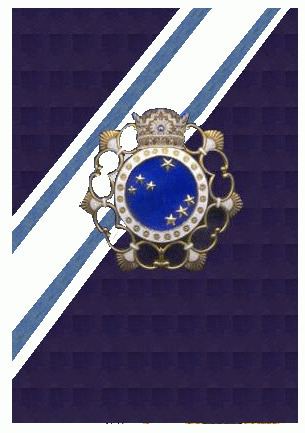Type Dynastic Order | Royal house House of Pahlavi | |
 | ||
Grand Mistress Empress Farah, Dowager Empress Grades Dame Grand Cordon 1st Class, Dame Grand Cordon 2nd Class, Dame Established 1957 - 1979 (National Order)1979 - present (House Order) | ||
The Order of the Pleiades (Persian: نشان هفتپیکر Nishân-i-Haftpaykar), also named Order of Haft Paykar, was an all-female order of the former Imperial State of Iran.
Contents
History
The Order was instituted in 1957 by the last Shah of Iran, Mohammad Reza Pahlavi. It consisted of three classes (1st class, 2nd class, and 3rd class), and was awarded to female persons of high status, for deserving special recognition or conspicuous appreciation by the Shah.
It is believed that the Order honours Soraya Esfandiary-Bakhtiari, the second wife of the former Shah Mohammad Reza Pahlavi. The name of the order refers to the Pleiades, a star cluster located in the constellation Taurus in the northern hemisphere. Soraya is a female Persian name with a reference to the Pleiades.
The order was abolished by the Islamic Republic of Iran after the fall of the last Shah. Since then, the order merely continues as a Royal Family Order, and Empress Farah Pahlavi, the third wife and widow of Shah Mohammad Reza Pahlavi, is still the grandmaster of this order.
Classes
Attached to the order are three medals: first class in gold, second class in gold and silver, and third class in silver. They were usually awarded to female members of the Imperial Household for long or faithful service. The medals are worn suspended from a bow.
Insignia
The sash badge of the first class is a round medallion made of gold gilt surrounded by six open ornaments, shaped as large double loops in gold; with between the ornaments partly white enameled, small shell-shaped designs. The central disc is made of blue enamel, with placed on it seven golden stars, topped with brilliants, and depicting the star cluster Pleiades. Furthermore, the disc itself is surrounded by a white enamel and gold edged ring with twenty-four stars thereon, made of gold and brilliants. The disc is topped by a stylized imperial Pahlavi Crown, enameled in different colors and enriched with carbuncles and brilliants.
The shoulder badge is similar to the sash badge, but is larger in appearance.
The sash badge of the second class is almost identical to the badge of the first class, but instead the medallion and the stars on it are made in silver gilt only. Similarly, the crown is enameled without the carbuncles and brilliants.
The star consists of a blue enameled central disc, with placed on it seven golden stars, topped with brilliants, representing the stars of the cluster Pleiades. The disc is surrounded by a white enamel and gold edged ring with twenty-four stars thereon, made of gold and brilliants. This as a whole is surrounded by six open ornaments, shaped as large double loops in gold; with between the ornaments partly white enameled, small shell-shaped designs. The disc is topped by a stylized imperial Pahlavi Crown, enameled in different colors and enriched with carbuncles and brilliants. At the back a pin is attached to wear the star on the left breast.
The sash is made of a white coloured silk moiré ribbon, with dark blue stripes near the borders. The badge is attached to the sash by a suspension ring from the top of the crown.
The medals show the image of the badge of the order as a full raised relief. The rim includes a large lip, on which the seven small, shell-like designs rest. The medals are topped with the stylized imperial Pahlavi Crown to which a simple ring is attached. The medals are unenameled and identical in appearance, except for the metal pertaining to the particular class.
